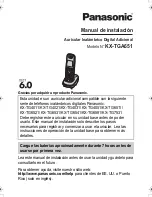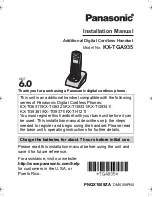
6
Maintenance
Taking care of your telephone
Your cordless telephone contains sophisticated electronic parts, so it must be treated with care.
Avoid rough treatment
Place the handset down gently. Save the original packing materials to protect your telephone if you ever need
to ship it.
Avoid water
Your telephone can be damaged if it gets wet. Do not use the handset outdoors in the rain, or handle it with
wet hands. Do not install the telephone base near a sink, bathtub or shower.
Electrical storms
Electrical storms can sometimes cause power surges harmful to electronic equipment. For your own safety,
take caution when using electrical appliances during storms.
Cleaning your telephone
Your telephone has a durable plastic casing that should retain its luster for many years. Clean it only with a soft
cloth slightly dampened with water or mild soap. Do not use excess water or cleaning solvents of any kind.
About cordless telephones
Privacy:
The same features that make a cordless telephone convenient create some limitations.
Telephone calls are transmitted between the telephone base and the cordless handset by radio
waves, so there is a possibility that the cordless telephone conversations could be intercepted by radio
receiving equipment within range of the cordless handset. For this reason, you should not think of
cordless telephone conversations as being as private as those on corded telephones.
Electrical power:
The telephone base of this cordless telephone must be connected to a working
electrical outlet. The electrical outlet should not be controlled by a wall switch. Calls cannot be made
from the cordless handset if the telephone base is unplugged, switched off or if the electrical power
is interrupted.
Potential TV interference:
Some cordless telephones operate at frequencies that may cause
interference to televisions and VCRs. To minimize or prevent such interference, do not place the
telephone base of the cordless telephone near or on top of a TV or VCR. If interference is experienced,
moving the cordless telephone farther away from the TV or VCR often reduces or eliminates the
interference.
Rechargeable batteries:
Exercise care in handling batteries in order not to create a short circuit with
conducting material such as rings, bracelets, and keys. The battery or conductor may overheat and
cause harm. Observe proper polarity between the battery and the battery charger.
Nickel-metal hydride rechargeable batteries:
Dispose of these batteries in a safe manner. Do not
burn or puncture the battery. Like other batteries of this type, if burned or punctured, they could release
caustic material which could cause injury.
The RBRC
®
seal
The RBRC
®
seal on the nickel-metal hydride battery indicates that VTech Communications, Inc. is voluntarily
participating in an industry program to collect and recycle these batteries at the end of their useful lives, when
taken out of service within the United States and Canada.
The RBRC
®
program provides a convenient alternative to placing used nickel-metal hydride batteries into the
trash or municipal waste, which may be illegal in your area.
VTech’s participation in RBRC
®
makes it easy for you to drop off the spent battery at local retailers
participating in the RBRC
®
program or at authorized VTech product service centers. Please call
(800) 8 BATTERY
TM
for information on Ni-MH battery recycling and disposal bans/restrictions in your area.
VTech’s involvement in this program is part of its commitment to protecting our environment and conserving
natural resources.
RBRC
®
is a registered trademark of Rechargeable Battery Recycling Corporation.
FCC, ACTA and IC regulations
FCC Part 15
This equipment has been tested and found to comply with the requirements for a Class B digital device
under Part 5 of the Federal Communications Commission (FCC) rules. These requirements are intended
to provide reasonable protection against harmful interference in a residential installation. This equipment
generates, uses and can radiate radio frequency energy and, if not installed and used in accordance with
the instructions, may cause harmful interference to radio communications. However, there is no guarantee
that interference will not occur in a particular installation. If this equipment does cause harmful interference
to radio or television reception, which can be determined by turning the equipment off and on, the user is
encouraged to try to correct the interference by one or more of the following measures:
Reorient or relocate the receiving antenna.
Increase the separation between the equipment and receiver.
Connect the equipment into an outlet on a circuit different from that to which the receiver is connected.
Consult the dealer or an experienced radio/TV technician for help.
Changes or modifications to this equipment not expressly approved by the party responsible for compliance
could void the user’s authority to operate the equipment.
This device complies with Part 5 of the FCC rules. Operation is subject to the following two conditions:
() this device may not cause harmful interference, and () this device must accept any interference received,
including interference that may cause undesired operation. Privacy of communications may not be ensured
when using this telephone.
To ensure safety of users, the FCC has established criteria for the amount of radio frequency energy that can
be safely absorbed by a user or bystander according to the intended usage of the product. This product has
been tested and found to comply with the FCC criteria. The handset may be safely held against the ear of the
user. The telephone base shall be installed and used such that parts of the user’s body other than the hands
are maintained at a distance of approximately 0 cm (8 inches) or more.
This Class B digital apparatus complies with Canadian requirement:
CAN ICES-3 (B)/NMB-3(B).
FCC Part 68 and ACTA
This equipment complies with Part 68 of the FCC rules and with technical requirements adopted by the
Administrative Council for Terminal Attachments (ACTA). The label on the back or bottom of this equipment
•
•
•
•
•
•
•
•
•
Remember that electrical appliances can cause serious injury if used when you are wet or standing in
water. If the telephone base should fall into water, DO NOT RETRIEVE IT UNTIL YOU UNPLUG THE
POWER CORD AND TELEPHONE LINE CORD FROM THE WALL. Then remove the telephone by the
unplugged cords.



























